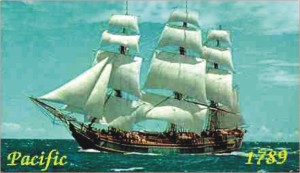| Classic Corner
Mutiny on the Bounty
By Charles Nordhoff and James Norman Hall
 Bounty tells the tale of the eponymous ship. Set in late 1787, the story follows a journey from Britain to Tahiti to obtain breadfruit trees. The action focuses on the boat's leader, Captain Bligh and his first mate, Fletcher Christian. Christian forces civilians to join the crew, and wealthy young Roger Byam eagerly hops on the voyage to help develop a Tahitian dictionary, among other duties. Bounty tells the tale of the eponymous ship. Set in late 1787, the story follows a journey from Britain to Tahiti to obtain breadfruit trees. The action focuses on the boat's leader, Captain Bligh and his first mate, Fletcher Christian. Christian forces civilians to join the crew, and wealthy young Roger Byam eagerly hops on the voyage to help develop a Tahitian dictionary, among other duties.
The mutiny on the Bounty was a mutiny aboard a Royal Navy ship on April 28, 1789 that has been made famous by several books, films, and other media such as songs. The mutiny was led by Fletcher Christian against the captain, William Bligh. Bligh was then cast adrift in a small open boat with 18 loyal men.
The Mutiny on the Bounty, involving no demands from the crew, the seizure of a ship by violence, and setting the captain and loyal crew members adrift, was extremely unusual.
Background
His Majesty's Armed Vessel (HMAV) Bounty began her career as the collier Bethia, built in 1784 at the Blaydes shipyard near Hull. Later she was purchased by the Royal Navy for £2,600 on May 26, 1787 (JJ Colledge/D Lyon say 23rd May), refitted, and renamed Bounty.
She was a relatively small sailing ship at 215 tons, three-masted and full-rigged. Her conversion for the breadfruit expedition mounted only four four pounders (2 kg cannon) and ten swivel guns. By way of comparison to other converted three-mast colliers used for similar expeditions, Cook's Endeavour displaced 368 tons and Resolution 462 tons.
The only two men ever to command her as the Bounty were Lieutenant William Bligh and Fletcher Christian, the latter of whom illegally took command through mutiny. Bligh was appointed Commanding Lieutenant of Bounty on August 16, 1787, at the age of 33, after a career that included a tour as sailing master of James Cook's HMS Resolution during Cook's third voyage (1776-1779). Though commonly portrayed as the epitome of abusive sailing captains, this portrayal has recently come into dispute.
The ship had been purchased by the Royal Navy for a single mission in support of an experiment: they were to travel to Tahiti, pick up breadfruit plants, and transport them to the West Indies in hopes that they would grow well there and become a cheap source of food for slaves. The experiment was proposed by Sir Joseph Banks, who recommended Bligh as commander, and was promoted through a prize offered by the Royal Society of Arts.
On December 23, 1787, Bounty sailed from Spithead for Tahiti. For a full month, she attempted to round Cape Horn, but adverse weather blocked her. Bligh ordered her turned about, and proceeded east, rounding the Cape of Good Hope and crossing the width of the Indian Ocean. During the outward voyage, Bligh demoted the ship's Sailing Master, John Fryer, replacing him with Fletcher Christian, whom he appointed acting Lieutenant. This act seriously damaged the relationship between Bligh and Fryer, and Fryer would later claim Bligh's act was entirely personal.
Bounty reached Tahiti on October 26, 1788, after ten months at sea.
Bligh and his crew spent five months in Tahiti, then called Otaheite, collecting and preparing a total of 1015 breadfruit plants. Bligh allowed the crew to live ashore and care for the potted breadfruit plants, and they became socialized to the customs and culture of the Tahitians. Many of the seamen and some of the "young gentlemen" had themselves tattooed in native fashion. Master's Mate and Acting Lieutenant Fletcher Christian married Maimiti, a Tahitian woman. Other warrant officers and seamen of the Bounty were also said to have formed "connections" with native women.
Three crewmen deserted and were recaptured. Instead of hanging them, as the crime of desertion was usually punished, Bligh ordered them flogged. Of these, at least one, James Morrison, would be among the mutineers.
Read the book to know what happened at the end.
Copyright
(R) thedailystar.net 2007 |
